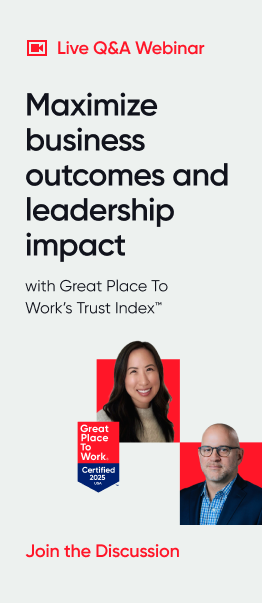Employee Listening, ERGs, Listening
The questions you ask employees about their experience at work could predict how well your business performs this year.
Employee listening is the central pillar of a healthy workplace and thriving culture — so why are so many companies getting it wrong?
There’s a difference between having just one annual employee engagement survey and listening programs that provide continuous, rich feedback from workers. Leaders at Synchrony, Encore and Dow shared how they listen to employees and how those efforts have led to innovation in their organizations in a Fortune Roundtable on Nov. 11.
Hear from more inspiring leaders at our next For All™ Summit May 7-9, 2024 in New Orleans
“The relationship between companies and employees has fundamentally changed,” says Brian Doubles, CEO of Synchrony. “Employees are seeking out companies that listen to them, where they feel supported.”
Transparency and open dialogue at Synchrony means hosting “Ask Us Anything” sessions, open to 20,000 employees, where leaders sit on the call until there are no more questions from the audience. Started during the pandemic, these calls continue to be a crucial tool for taking the pulse of employees, Doubles says.
“A lot of what we are doing right now, I call it ‘The Great Experiment,’” Doubles says. “We are figuring it out by listening to employees.”
Watch video of the roundtable here:
A need for experimentation
As employee priorities have changed, the best workplaces are piloting new programs and workflows to meet the needs of their people.
“Employees are rethinking their approach to work and what they want to get out of it,” says Alveda Williams, chief inclusion officer at Dow.
The company has responded by launching programs like “Design Your Day” where employees can set their workday to fit the needs of their team, their work and their personal lives. That could include meeting-free Fridays for more focus time, certain days working from home, or even a relaxed dress code when appropriate.
Synchrony has also been experimenting with remote work and workplace flexibility.
“Very early on, we decided to embrace this hybrid, flexible work arrangement,” Doubles says. “We are experimenting and trying to figure this out.”
One of the big debates going on in the organization is what activities can be conducted remotely and what activities require teams to meet in-person.
“Some of the things we tried to do around training and development [that were remote] didn’t work,” Doubles says.
After listening to employees, Synchrony is changing its approach. “We’re experimenting and investing in a lot of new technologies,” he says.
At companies like Encore, a live and virtual events producer, experimentation has come in response to business and industry changes. New, younger workers have brought new expectations to the workforce where Encore competes, and generational change has spurred new ideas.
“We’ve done a lot around how do we design training programs,” says Ben Erwin, CEO of Encore. Changes have been designed to accelerate people in their careers, and gamifying training to engage younger workers who crave training and education, but want to engage in different ways.
Employee resource groups as listening tools
Listening to employees requires more than just one annual engagement survey. Employee resource groups (ERGs) have been crucial for organizations like Dow to surface employee perspectives.
“The ‘R’ stands for resource,” says Williams. “They are a resource of the employees, but they are also a resource for the company.”
At Dow, 60% of employees participate in an ERG and these groups have had a powerful impact across the company. Williams points to Dow’s expanded parental leave policy (16 weeks paid leave for both birthing and non-birthing new parents) as an offering that came from members of the Women’s Inclusion Network, an ERG supporting the professional development of women at Dow.
At Synchrony, ERGs were responsible for surfacing the need for mental wellness coaches with similar life experiences to the individuals they were mentoring.
"If you are listening to your employees… that is where we get our best ideas,” says Doubles. “You’re not going to get it sitting around the table with the executive leadership team trying to come up with programs to support employees. It really has to be co-created, co-developed with them.”
Encore has launched a resource group specifically to address employee well-being across the organization, and the group partners with other resource groups to find ideas and increase support for employees. “Well-being is something that touches every community,” says Erwin.
Tips for listening
Leaders shared several ideas for how organizations can ensure more employees are being heard on the issues that matter to them:
1. Convene influencers.
At Dow, people leaders and influential individual contributors are brought together to form a community that can offer feedback to the executive team. The CEO meets quarterly with the group right after the earnings call with investors.
“You get away from this telephone game,” Williams explains, highlighting the importance of increasing employees’ direct access to top leaders. “It’s an opportunity for people to get clear direction.”
2. Ask one question.
Synchrony has had singular success in having targeted, intentional listening sessions with 15-20 employees. In the one-hour session, leaders ask just one question: “What’s not working?”
Leaders come out of the session with a handful of important items, and they make sure to follow-up with every issue. “We make sure that group feels that they were heard,” says Doubles.
3. Get employees talking to each other.
“Communication is more complicated today,” says Erwin. “As much as I would love to think that everyone is going to read an email that I send out — not everyone is going to read the email.”
Encore has found success in grassroots efforts where team members come up with ideas for their own communications channels, such as a podcast.
Frontline employees have been tuning in to hear from one of their colleagues, and listening in a different way than how they might engage with a call from senior executives.
“How do you use some of the internal social media channels?” Erwin asks. “It’s not for us to control what is being talked about … It’s increasing the transparency in the organization about what is on people’s minds.”
Get more insights
Learn more strategies from our workplace culture experts at our For All™ Summit, April 8-10, 2025 in Las Vegas, NV.











